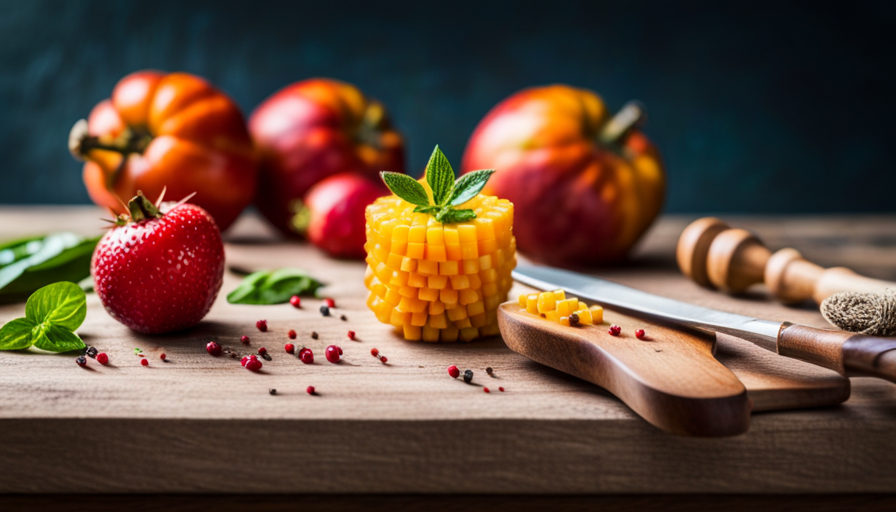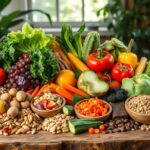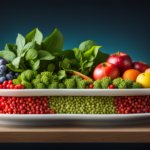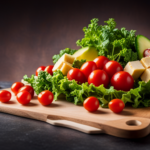Oh, the delight of following a raw food diet! It’s like entering a realm where the abundance of nature is your sole compass.
No more cooking, no more processed foods, just pure, unadulterated goodness.
So, what can I eat on this divine journey? Well, my friend, the options are endless.
Fruits and vegetables become your best companions, providing a burst of vitamins and minerals with every bite.
Nuts and seeds add a delightful crunch and a dose of healthy fats.
Sprouts and microgreens bring a fresh and vibrant twist to your meals.
And don’t forget about raw grains and legumes, ferments, sweeteners, oils, fats, and even desserts and treats that keep your taste buds dancing.
And of course, hydration is key, so indulge in refreshing fruits and veggies to quench your thirst.
So, put on your apron (or not), grab your knife, and embark on this delicious adventure of nourishing your body the raw way.
Key Takeaways
- Raw food diet emphasizes unprocessed, pure, and natural foods.
- Fruits and vegetables provide vitamins, minerals, and antioxidants.
- Nuts and seeds are a source of healthy fats and protein.
- Sprouts and microgreens add flavor and nutrition to meals.
Fruits and Vegetables
You’ll be amazed by the vibrant colors and incredible flavors of the fruits and vegetables you can enjoy on a raw food diet. Not only are they delicious, but they also offer a myriad of health benefits.
A fruit-based raw food diet is packed with essential vitamins, minerals, and antioxidants that support overall health and well-being. Fruits are also low in calories and high in fiber, making them a perfect choice for weight management. They’re a great source of natural sugars, providing a quick burst of energy without the crash that comes from processed sugars.
When it comes to incorporating vegetables into a raw food diet, the possibilities are endless. From salads to smoothies, there are so many creative ways to enjoy the goodness of raw vegetables. You can spiralize zucchini to create a tasty pasta alternative or use lettuce leaves as a wrap for your favorite fillings. Adding vegetables like kale, spinach, and cucumber to your green smoothies can boost their nutritional content and add a refreshing twist.
Transitioning to the next section about nuts and seeds, you’ll discover that they’re an essential part of a raw food diet.
Nuts and Seeds
Craving a crunchy snack? How about indulging in the rich, nutty flavors of roasted almonds and sunflower seeds? Nuts and seeds aren’t just delicious, but they’re also packed with nutritional benefits that make them an excellent addition to a raw food diet.
They’re a great source of protein, healthy fats, fiber, vitamins, and minerals. Almonds, for example, are rich in vitamin E, magnesium, and calcium, while sunflower seeds provide a good amount of vitamin B6 and selenium.
Incorporating nuts and seeds into a raw food diet can be done in creative ways. You can sprinkle them on top of salads for added crunch and flavor, or blend them into smoothies for a creamy texture. Another option is to make homemade nut and seed butters, which can be used as a spread or dipping sauce. Additionally, you can use ground nuts and seeds to make raw food crusts for desserts or as a topping for raw food granolas.
Transitioning to the next section about ‘sprouts and microgreens’, these tiny powerhouses of nutrition can provide even more variety and nutrients to a raw food diet.
Sprouts and Microgreens
Adding sprouts and microgreens to your meals will bring a burst of vibrant colors and fresh flavors that’ll elevate your culinary experience. These tiny greens are packed with nutrients and offer numerous benefits for your health.
Sprouts, such as alfalfa and broccoli sprouts, are rich in antioxidants, enzymes, and vitamins. They’ve been shown to support digestion, boost the immune system, and reduce the risk of chronic diseases.
Microgreens, on the other hand, are young vegetable greens that are harvested just after the first leaves have developed. They’re even more nutrient-dense than their mature counterparts, containing higher levels of vitamins and minerals.
There are many ways to incorporate sprouts and microgreens into your raw food diet. You can add them to salads, wraps, and sandwiches for an extra crunch and burst of flavor. They also make a great topping for soups or smoothie bowls.
Another option is to use them as a base for raw food sushi rolls, creating a colorful and nutritious meal. Additionally, you can blend them into pesto or sauces to add a fresh and vibrant taste.
Transitioning into the next section on raw grains and legumes, it’s important to note that these sprouts and microgreens can be combined with other raw ingredients to create delicious and nutritious meals. Raw grains and legumes offer a variety of textures and flavors that can further enhance your raw food experience.
Raw Grains and Legumes
Transitioning into the world of raw grains and legumes opens up a whole new realm of textures and flavors to explore in my culinary journey. On a raw food diet, it’s important to find alternatives to cooked grains. Luckily, there are plenty of options available.
Raw grain alternatives like buckwheat groats, quinoa, and amaranth can be soaked and sprouted, making them easier to digest and enhancing their nutritional value. These raw grains provide a nutty and chewy texture, adding depth to salads, porridges, and even raw desserts.
In addition to raw grains, incorporating raw legumes into my diet has been a game-changer. Sprouted lentils, chickpeas, and mung beans are packed with essential nutrients, including protein, fiber, and vitamins. Raw legumes can be used in salads, wraps, and even blended into creamy dips like hummus. They not only add a satisfying crunch but also provide a hearty and filling element to raw food meals.
Transitioning from sprouts and microgreens to raw grains and legumes has allowed me to expand my culinary repertoire and create more diverse and satisfying raw food dishes. However, there’s still one more important aspect to explore in the world of raw food: raw fermented foods.
Raw Fermented Foods
To fully immerse yourself in the world of raw fermentation, you’ll discover that incorporating raw fermented foods into your meals is like adding a burst of tangy flavor that dances on your taste buds, much like a symphony of zesty notes. Fermentation is a natural process that enhances the flavor and nutritional value of foods. It involves the breakdown of carbohydrates by microorganisms like bacteria and yeast, resulting in the production of beneficial compounds such as enzymes, probiotics, and vitamins.
Including raw fermented foods in your diet can offer numerous health benefits. The process of fermentation helps to increase the bioavailability of nutrients, making them easier for your body to absorb. It also promotes a healthy gut by introducing beneficial bacteria, which can improve digestion and boost the immune system. Some popular raw fermented food options include sauerkraut, kimchi, kombucha, and kefir.
Here is a table with some examples of raw fermented foods and their potential benefits:
| Raw Fermented Food | Potential Benefits |
|---|---|
| Sauerkraut | Rich in probiotics |
| Kimchi | Supports digestion |
| Kombucha | Detoxifies the body |
| Kefir | Boosts immune system |
Incorporating these foods into your raw food diet can provide a delightful tanginess to your meals while offering a range of health benefits. Transitioning into the subsequent section about raw dairy and animal products (if desired), you can explore other options to complete your raw food journey.
Raw Dairy and Animal Products (if desired)
If you’re interested in exploring a wider range of options in your journey towards a raw and natural lifestyle, you might consider incorporating raw dairy and animal products into your meals.
While raw dairy products such as milk, cheese, and yogurt aren’t commonly consumed on a raw food diet, there are alternatives that can be considered. Raw plant-based milk, made from nuts or seeds, can be a great substitute for traditional dairy milk. It provides similar nutrients and can be used in various recipes.
When it comes to animal products, ethical considerations should be taken into account. If you choose to consume raw animal products, it’s important to source them from organic, pasture-raised animals that’re treated humanely. This ensures that the animals aren’t exposed to antibiotics, hormones, or other harmful substances.
Incorporating raw dairy and animal products can add variety to your raw food diet, providing you with additional nutrients and flavors. However, it’s crucial to listen to your body and make choices that align with your health goals and ethical values.
Transitioning into the subsequent section about raw sweeteners, it’s important to note that there’re natural alternatives to refined sugar that can be enjoyed on a raw food diet.
Raw Sweeteners
Looking for a natural way to satisfy your sweet tooth without compromising your health goals and ethical values? Look no further than raw sweeteners! These natural alternatives provide a healthier option for those who follow a raw food diet.
Raw sweeteners, such as raw honey, maple syrup, and coconut nectar, offer a variety of health benefits. They contain enzymes, antioxidants, and minerals that can support digestion, boost the immune system, and provide a quick energy source. Unlike refined sugars, raw sweeteners are minimally processed and retain their natural goodness.
Raw honey, for example, is known for its antimicrobial properties and can help soothe a sore throat or cough. Maple syrup is rich in antioxidants and can provide a natural source of vitamins and minerals. Coconut nectar is low on the glycemic index, making it a suitable option for those watching their blood sugar levels.
Incorporating these raw sweeteners into your diet can add a touch of natural sweetness to your meals and snacks. They can be used in smoothies, desserts, dressings, and even as a topping for pancakes or oatmeal. By choosing raw sweeteners, you can enjoy the health benefits without compromising on taste.
Now, let’s transition to the next section about raw oils and fats, where we’ll explore the importance of incorporating these essential nutrients into a raw food diet.
Raw Oils and Fats
Indulging in the rich flavors of raw oils and fats brings a lusciousness to your meals, like a velvety drizzle of avocado oil on a vibrant salad or the creamy decadence of raw cacao butter in a guilt-free dessert. Raw oils and fats provide numerous benefits when incorporated into a raw food diet. Here are four reasons why you should consider adding them to your meals:
-
Essential nutrients: Raw oils and fats, such as coconut oil and flaxseed oil, are rich in essential fatty acids like omega-3s, which are crucial for brain health and reducing inflammation.
-
Enhanced absorption of nutrients: The presence of healthy fats in raw meals aids in the absorption of fat-soluble vitamins like A, D, E, and K. These vitamins play a vital role in maintaining overall health.
-
Increased satiety: Including raw oils and fats in your meals can help you feel fuller for longer, reducing the temptation to snack on unhealthy options.
-
Improved flavor and texture: Raw oils and fats add a delicious richness to your dishes, making them more satisfying and enjoyable to eat.
Incorporating raw oils and fats into your meals can elevate your raw food experience and provide numerous health benefits. Now, let’s explore the world of raw desserts and treats.
Raw Desserts and Treats
Get ready to satisfy your sweet tooth with an array of delectable raw desserts and treats that will leave you craving for more! When following a raw food diet, there are plenty of options available to indulge in without sacrificing taste or health benefits. Raw desserts and treats are made from natural, uncooked ingredients, preserving their nutritional value and providing a guilt-free indulgence.
To give you some inspiration, here are a few raw dessert recipes that are both delicious and nutritious:
| Dessert | Ingredients |
|---|---|
| Raw Chocolate Mousse | Avocado, cacao powder, dates, almond milk, maple syrup |
| Raw Key Lime Pie | Cashews, dates, lime juice, coconut oil, agave syrup |
| Raw Energy Balls | Medjool dates, nuts (such as almonds or walnuts), shredded coconut, cacao powder, chia seeds |
These recipes are just the beginning, and the possibilities for raw desserts are endless. Not only do these treats taste amazing, but they also come with a range of benefits. Raw desserts are packed with vitamins, minerals, and antioxidants, promoting better digestion, glowing skin, and increased energy levels.
As we move on to the next section about hydration, it’s important to remember that raw desserts can also contribute to your overall water intake.
Hydration
Staying hydrated is crucial for maintaining optimal health and can be easily achieved by incorporating hydrating beverages and foods into your daily routine. When following a raw food diet, it’s important to pay special attention to hydration because many raw fruits and vegetables have high water content. By consuming these foods, you not only nourish your body with essential nutrients, but also keep it hydrated.
There are several benefits of staying hydrated on a raw food diet. Proper hydration helps to flush out toxins from your body, aids in digestion, and supports healthy skin. It also helps to regulate body temperature and lubricate joints. When you’re properly hydrated, you may experience increased energy levels and improved mental clarity.
To incorporate more hydration into your raw food diet, start by drinking plenty of water throughout the day. Aim for at least eight glasses of water daily. Additionally, include hydrating fruits and vegetables in your meals and snacks. Some examples include watermelon, cucumber, oranges, and berries. You can also make refreshing smoothies or juices using these hydrating ingredients.
Staying hydrated is essential when following a raw food diet. By consuming hydrating beverages and foods, you can reap the numerous benefits of proper hydration, such as improved digestion and increased energy levels. Remember to drink plenty of water and include hydrating fruits and vegetables in your daily meals to stay properly hydrated.
Frequently Asked Questions
Are there any specific fruits and vegetables that should be avoided on a raw food diet?
There aren’t any specific fruits and vegetables that should be avoided on a raw food diet. In fact, including a variety of fruits and vegetables is highly recommended for their numerous health benefits.
However, it’s important to note that a raw food diet typically excludes the consumption of raw meat. Instead, alternatives such as nuts, seeds, sprouts, and fermented foods can provide valuable sources of protein and other essential nutrients.
Can I eat roasted or salted nuts and seeds on a raw food diet?
Roasted nuts and salted seeds are not typically consumed on a raw food diet. These foods undergo heating and processing, which goes against the principles of raw foodism. The aim of a raw food diet is to consume uncooked and unprocessed foods in their natural state to preserve their enzymes and nutrients. Instead, opt for raw nuts and seeds, which are more aligned with the principles of this diet.
How can I incorporate sprouts and microgreens into my meals?
To incorporate sprouts and microgreens into my meals, I can try various recipes. For instance, I can add them to salads, smoothies, or wraps to enhance their nutritional value and add a fresh, vibrant taste.
Sprouts and microgreens are rich in vitamins, minerals, and antioxidants, which can provide numerous health benefits when included in a raw food diet. Adding these nutrient-dense ingredients can help boost immunity, support digestion, and promote overall well-being.
Are there any raw grains and legumes that require special preparation techniques?
Yes, there are raw grains and legumes that require special preparation techniques on a raw food diet. Soaking is a common technique used for raw grains and legumes to enhance their digestibility and nutrient availability. It involves soaking them in water for a certain period of time, usually overnight, before consumption.
Sprouting is another method used to make raw grains and legumes more nutritious. This process involves allowing them to germinate by rinsing and draining them regularly until sprouts appear.
These techniques can help improve the nutritional profile and digestibility of raw grains and legumes on a raw food diet.
What are some examples of raw fermented foods and their health benefits?
Fermented foods are all the rage these days, and for good reason! They not only add a tangy flavor to your meals, but they also offer numerous benefits for gut health. Fermentation promotes the growth of beneficial bacteria, which can improve digestion and boost your immune system.
Some examples of raw fermented foods include sauerkraut, kimchi, and kefir. Want to try making your own? Easy recipes for homemade fermented foods can be found online, so get fermenting and reap the gut-loving rewards!
Can Older Individuals Follow a Raw Food Diet Safely?
Yes, using raw food older individuals can safely follow a raw food diet with proper planning and attention to nutrient intake. It’s important to consult with a healthcare professional to ensure that all nutritional needs are being met, especially with regards to protein, vitamins, and minerals.
Conclusion
In conclusion, embracing a raw food diet opens up a world of vibrant and nourishing options. Picture yourself biting into a juicy, sun-ripened strawberry or savoring the creamy richness of an avocado. Imagine the delicate crunch of fresh sprouts and the earthy goodness of raw nuts and seeds.
With the right balance of fruits, vegetables, grains, and fermented foods, this diet can provide the essential nutrients your body needs to thrive. So, let the colors and flavors of raw food ignite your senses and embark on a journey towards optimal health.

















